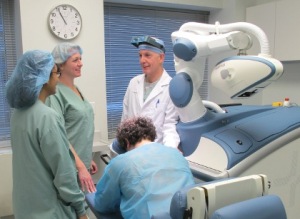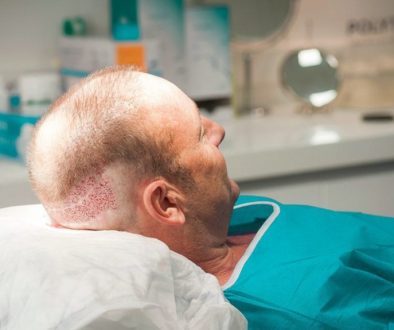Dr. Robert Bernstein Discusses the ARTAS Hair Restoration System for Automating Follicular Unit Extraction (FUE)
Since the late 1990’s, Coalition hair transplant surgeon Dr. Robert Bernstein has been a follicular unit extraction innovator. Between researching FUE in its infancy stages and co-authoring the original paper on the FUE method in 2002, Dr. Bernstein has made a name for himself as an FUE pioneer. More recently, Dr. Bernstein investigated and purchased the new ARTAS Hair Restoration System for automating follicular unit extraction (FUE).
Because this system is quite innovative in that it can automatically extract follicular units from the donor site using its controls, we asked him for his expert opinion and impression of the ARTAS. See our detailed interview with him below.
Robotic FUE at Bernstein Medical
Dr. Bernstein, discuss your experience with Robotic-FUE
 I began performing FUE in the late 1990’s, although, at the time, it was a very small part of my practice. When Dr. Rassman and I wrote the first paper on Follicular Unit Extraction in 2002 (the paper which gave FUE its name), we stressed the difficulty of harvesting intact follicular units using a hand-held punch. [1] We found that there was such great variability in the transection rate between patients that we recommended performing a test (the Fox Test) on all patients prior to scheduling the actual procedure. This was done in order to determine who would be a good candidates and in which patients the risk of follicular damage would be too great to make the procedure practical.
I began performing FUE in the late 1990’s, although, at the time, it was a very small part of my practice. When Dr. Rassman and I wrote the first paper on Follicular Unit Extraction in 2002 (the paper which gave FUE its name), we stressed the difficulty of harvesting intact follicular units using a hand-held punch. [1] We found that there was such great variability in the transection rate between patients that we recommended performing a test (the Fox Test) on all patients prior to scheduling the actual procedure. This was done in order to determine who would be a good candidates and in which patients the risk of follicular damage would be too great to make the procedure practical.
After trying a variety of different instruments and techniques, a major breakthrough came with Dr. Harris’ idea to use a three-step technique in which a sharp-punch was used to score the skin and then a dull punch was used to go deeper and separate the follicular units from the surrounding tissue (the third step was the actual extraction using forceps, so we now just refer to it as the 2-step technique). Using a dull punch for the dissection in step two allowed us to minimize injury to the follicles; however, there was a relatively high incidence of buried grafts when the sharp instrument was removed and the dull instrument inserted. [2-4]
The logistical problem of using two distinct steps was elegantly solved by Jim Harris’ SAFE system. A single, rotating punch would act as a sharp instrument (when rotating quickly) and then a blunt instrument (as it rotated more slowly). [5] The beauty of the instrument was that, as the punch advanced deeper into the skin, the friction on the punch from the surrounding skin would automatically slow the rotation so that only the initial, entry-speed adjustment had to be made.
This instrument decreased the incidence of transection and also of buried grafts. Problems remained, however, as a number of patients still had unacceptable rates of transection, particularly those with finer hair and very loose scalps. Another issue, of course, was that as FUE sessions grew larger (and longer), it became increasingly more difficult to achieve consistent results due to human error and fatigue.
The benefit of using a robotic device to minimize human error was obvious, but the main thing I like about the ARTAS System is that it uses sharp/blunt dissection — the technique we found worked best with the hand-held devices. It also allows us to remove grafts with forceps, rather than by suction. This feature is important, since the latter, in my opinion, is more damaging to grafts. It was these two reasons that prompted us, in November 2011, to become the first facility on the East Coast to introduce the technology into our practice. We now perform the majority of our FUE cases using the robotic system.
What are the benefits of the ARTAS System for your patients?
 The first step in FUE, namely, the separation of the follicular units from the surrounding donor tissue, is a highly repetitive and labor intensive process that requires great precision. This step requires centering the punch over the follicular unit and aligning the dissecting instrument with the follicles/follicular units, in order to prevent damage. This step, which must be repeated hundreds to thousands of times in a typical FUE hair restoration procedure, is the step that is most subject to human variability and error.
The first step in FUE, namely, the separation of the follicular units from the surrounding donor tissue, is a highly repetitive and labor intensive process that requires great precision. This step requires centering the punch over the follicular unit and aligning the dissecting instrument with the follicles/follicular units, in order to prevent damage. This step, which must be repeated hundreds to thousands of times in a typical FUE hair restoration procedure, is the step that is most subject to human variability and error.
The ARTAS System solves this problem by using an image-guided robotic arm to separate follicular units from the surrounding tissue for subsequent extraction. The robotic device is composed of a robotic arm, a punch mechanism, a video imaging system, disposable cartridges, and a user interface. Its extraction technique consists of a double punch arrangement with an inner sharp punch and outer duller punch. The inner punch has cutting capabilities, to score the upper most part of the skin, and the outer punch has a blunt edge, used for dissection of the follicular units from the surrounding tissue, which minimizes injury to the grafts. The consistency in performing this task thousands of times without its accuracy waning from fatigue is a main befit of using a robot for follicular unit extraction.
Another advantage of robotic FUE is that we have found that grafts, which were harvested with robotic FUE, showed less transection (compared to a hand-held device) and contained more of the surrounding protective tissue, particularly around the lower portion of the follicular unit. One would assume that the better quality grafts will lead to increased graft survival, but this has not yet been tested in controlled studies.
We also find the robot to be more versatile in its ability to harvest grafts from patients with different hair characteristics and from different parts of the scalp. Although there is still variability in the ease of extraction among patients of different racial backgrounds, the differences are less compared to a hand-held system. Also, the robotic system is more easily able to extract grafts from the sides of the scalp where the hair angle is more acute.
The robotic system also reduces harvesting time, particularly in larger sessions where doctor and staff fatigue tends to set in. A hand-held device requires great effort to perform sessions over 1500 grafts. [6] We are now able to comfortably extract 2,000 grafts in one day and 2,500 or more over two consecutive days.
What improvements need to be made with the robotic system?
As with any new innovation, technology is perpetually evolving. We have been working closely with the staff at Restoration Robotics in developing modifications to improve the system, and they have been very receptive to suggestions and ideas.
The initial version of the robot required real-time adjustments in parameters such as the depth and angle of the punch and the speed of rotation. Although the imaging system of the robot allowed these changes to be made quite easily, there were a fair number of adjustments to monitor. Although it is a bit too technical to detail all the new modifications in this brief discussion, the result is a system that requires far less human intervention than with earlier iterations. The user interface has also been improved and automatic features added, so that the new robot is much easier to operate compared to the older versions.
One of the main modifications I made to the system was to decrease the diameter of the sharp punch from 1.0mm down to 0.9mm (with a concomitant decrease in the size of the blunt punch). This has an overall effect of decreasing the wounding to the donor area, facilitating healing, and increasing the number of grafts that could be obtained per unit area (by over 30%). It also produces grafts that we find are more “ready-made” for implantation, as grafts from the updated system require little or no trimming under the stereo-microscope prior to insertion.
There are several changes that still need to be made to the robot system to make it more practical. Fortunately, these changes are in the works. Currently, the patient can only lie on the robotic device face-down. This position is necessary for the robotic arm to have full access to the donor area, but it does not allow easy access to the front or top of the scalp. As a result, graft placement must be performed using a separate operating chair, necessitating the use of two operating rooms for one patient. Fortunately, we have the space at our center, but many offices, particularly those in places like New York City, do not have this much room available. Within a year, the robotic operating table will be re-designed so that harvesting and placing can be performed in the same room.
One of the things that slow down the robotic process is the tensor mechanism used to stretch the scalp. Although this feature has the advantage of decreasing follicular transection, it must be removed and applied to a new area every 100 to 150 grafts. With a larger and easier to use tensor (which has already been designed), the delay from its re-positioning should be significantly decreased.
The robot harvests grafts in a square field. When one field is finished, the tensor is manually advanced to the next area. With slight overlapping, one field can be made to imperceptibly blend into the next. However, the two ends of the harvested donor area have a squared-off look that persists until the donor area completely heals. With some easy programming of the fields, the outside edges can be gently feathered to produce a softer look, but this takes a little time. With a software upgrade currently in development, the robot should be able to do this automatically, eliminating one more step for the operating surgeon.
How have you integrated the robotic device into your thriving hair restoration practice?
Soon after we began using the ARTAS system, and could appreciate its benefits, I stopped using the hand-held system for all but the smallest FUE cases. Patients easily understood the advantages of the new device and did not need convincing to use it, especially since we charged the same fees for robotic FUE as we had for the manual FUE procedure.
The major changes we had to make after integrating robotic FUE into our practice were related to performing the larger sessions of FUE permitted by the new technology. Although the ability to harvest a greater number of grafts in one sitting is clearly an advantage, having grafts outside the body for an extended period of time can be detrimental to their growth. It also becomes physically difficult for both the patient and staff when procedures last significantly longer than eight hours.
In FUT, follicular units are obtained through the stereo-microscopic dissection of a harvested donor strip. Since this process takes place on a dissecting table, graft dissection can proceed simultaneously with site creation and graft placement. In addition, the dissection can be done by multiple dissectors working simultaneously to complete the process quickly. In FUE, however, individual follicular units are removed directly from the donor area, making it difficult for site creation and graft placement to be carried out at the same time. This is literally impossible using a robot for harvesting. In addition, the logistical constraints of extraction limit it to being performed one graft at a time, significantly increasing the duration of this step of the procedure. As a result, in FUE procedures, there is a delay from the time grafts are removed from the body until they can be placed into the recipient sites. This delay is, of course, magnified in larger FUE sessions.
To lessen the impact of this interval, we first started using the holding solution HypoThermosol in all of our cases, regardless of their size. This holding solution, with mimics the intra-cellular environment of grafts and soaks up damaging free-radicals, has been shown to increase survival outside the body. It is particularly effective at low temperatures, which we also control for with new digital technology.
The second change we made to lessen the delay was to simply create all the recipient sites before extracting the grafts. In this way, once the grafts are harvested, they can immediately be placed into the recipient scalp. In larger cases, of around 1800 to 2000 grafts, we have been pre-making the sites the day before. Not only does this eliminate the delay, but; by allowing the recipient sites to begin to heal; it minimizes popping, increases visibility due to less bleeding, and possibly creates a more hospitable environment for the newly transplanted grafts. [7]
The third change we made was to divide cases over 2,000 grafts into two, consecutive day sessions. This not only takes advantage of pre-making sites (which are all made on day one) in eliminating the site creation delay, but allows large sessions to be performed without stressing our patients or our staff.
References
- Rassman WR, Bernstein RM, McClellan R, Jones R, et al. Follicular Unit Extraction: Minimally invasive surgery for hair transplantation. Dermatol Surg 2002; 28(8): 720-7.
- Harris JA. The SAFE System: New Instrumentation and Methodology to Improve Follicular Unit Extraction (FUE). Hair Transplant Forum Intl. 2004; 14(5): 157, 163-4.
- Bernstein RM, Rassman WR. New Instrumentation for Three-Step Follicular Unit Extraction. Hair Transplant Forum International 2006; 16(1): 229, 237-9.
- Rassman WR, Harris J, Bernstein RM. Follicular Unit Extraction. In: Haber RS, Stough DB, editors: Hair Transplantation, Chapter 17. Elsevier Saunders, 2006: 133-137.
- Harris JA. Powered blunt dissection with the SAFE System for FUE Part I. Hair Transplant Forum Intl. 2010; 20(6): 188-189.
- Bernstein RM, Rassman WR. Anderson KW. Follicular Unit Extraction Megasessions: Evolution of a technique. Hair Transplant Forum International 2004; 14(3): 97-99.
- Bernstein RM, Rassman WR. Pre-Making Recipient Sites to Increase Graft Survival in Manual and Robotic FUE Procedures (Submitted for publication, 2012)
_______________
Blake – aka Future_HT_Doc
Editorial Assistant and Forum Co-Moderator for the Hair Transplant Network, the Hair Loss Learning Center, the Hair Loss Q&A Blog, and the Hair Restoration Forum
Follow our community on Twitter
Watch hair transplant videos on YouTube
Technorati Tags: hair transplant surgeon, follicular unit extraction, FUE, FUE method, ARTAS Hair Restoration System for automating follicular unit extraction (FUE).



